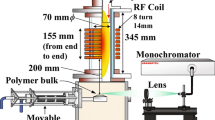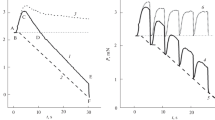Abstract
The plasma characteristics of carbon-doped glycidyl azide polymer (GAP) are investigated ablation by nanosecond laser pulses. For the GAP energetic liquid, a specific impulse of 840 s and an ablation efficiency up to 98% are obtained, which can be attributed to the low mass loss owing to the carbon doping. A comparison between the chemical energies shows that the carbon-doped GAP provides better propulsion than pure GAP. This indicates that even for an energetic liquid, an efficient approach to enhance the thrust performance is to reduce the splashing. High ablation thrust could be achieved at a low laser fluence and high carbon content.
Similar content being viewed by others
References
Luke J R, Phipps C R, McDuff G G. Laser plasma thruster. Applied Physics A, Materials Science & Processing, 2003, 77(2): 343–348
Ahmad M R, Jamil Y, Saeed H, Hussain T. A new perspective of ablative pulsed laser propulsion: study on different morphologies of nano-structured ZnO. Laser Physics Letters, 2015, 12(5): 056101
Fardel R, Urech L, Lippert T, Phipps C, Fitz-gerald J M, Wokaun A. Laser ablation of energetic polymer solutions: effect of viscosity and fluence on the splashing behavior. Applied Physics A, Materials Science & Processing, 2009, 94(3): 657–665
Phipps C, Luke J, Lippert T, Hauer M, Wokaun A. Micropropulsion using a laser ablation jet. Journal of Propulsion and Power, 2004, 20 (6): 1000–1011
Zheng Z Y, Zhang J, Zhang Y, Liu F, Chen M, Lu X, Li Y T. Enhancement of coupling coefficient of laser plasma propulsion by water confinement. Applied Physics A, Materials Science & Processing, 2006, 85(4): 441–443
Zheng Z Y, Zhang S Q, Liang T, Gao L, Gao H, Zhang Z L. Characteristics of droplets ejected from liquid glycerol doped with carbon in laser ablation propulsion. Chinese Physics B, 2016, 25(4): 045204
Zheng Z Y, Liang T, Zhang S Q, Gao L, Gao H, Zhang Z L. Ablation of carbon-doped liquid propellant in laser plasma propulsion. Applied Physics A, Materials Science & Processing, 2016, 122(4): 317
Fardel R, Urech L, Lippert T, Phipps C, Fitz-gerald J M, Wokaun A. Laser ablation of energetic polymer solutions: effect of viscosity and fluence on the splashing behavior. Applied Physics A, Materials Science & Processing, 2009, 94(3): 657–665
Urech L, Lippert T, Phipps C R, Wokaun A. Polymer ablation: from fundamentals of polymer design to laser plasma thruster. Applied Surface Science, 2007, 253(15): 6409–6415
Wang X Y, Wu L Z, Guo N, He N B, Shen R Q, Ye Y H. Preliminary study for effects of laser pulse width on propulsion performance of gap propellant doped with carbon. Journal of Propulsion Technology, 2016, 37(4): 788–792
Xue Y T, Dou Z G, Ye J F, Li N L, Zhang G Z, Wan Y. Experimental study on influence of splashing behavior on mechanical effects. High Power Laser and Particle Beams, 2014, 26(10): 101020
Zheng Z Y, Gao H, Gao L, Xing J, Fan Z J, Dong A G, Zhang Z L. Laser plasma propulsion generation in nanosecond pulse laser interaction with polyimide film. Applied Physics A, Materials Science & Processing, 2014, 115(4): 1439–1443
Choi S, Han T, Gojani A B, Yoh J J. Thrust enhancement via geltype liquid confinement of laser ablation of solid metal propellant. Applied Physics A, Materials Science & Processing, 2010, 98(1): 147–151
Phipps C R, Luke J K, Lippert T, Hauer M, Wokaun A. Micropropulsion using laser ablation. Applied Physics A, Materials Science & Processing, 2004, 79(4–6): 1385–1389
Sinko J E, Phipps C R. Modeling CO2 laser ablation impulse of polymers in vapor and plasma regimes. Applied Physics Letters, 2009, 95(13): 131105
Phipps C, Birkan M, Bohn W, Eckel H A, Horisawa H, Lippert T, Michaelis M, Rezunkov Y, Sasoh A, Schall W, Scharring S, Sinko J. Review: laser-ablation propulsion. Journal of Propulsion and Power, 2010, 26(4): 609–637
Acknowledgements
This project was supported by the Fundamental Research Funds for the Central Universities of China (Nos. 53200859165, 2562010050), and by the National Natural Science Foundation of China (Grant No. 11504337).
Author information
Authors and Affiliations
Corresponding author
Additional information
Jing Qi obtained the B.E. degree in Gemmology and Material Technology in 2016 from China University of Geosciences, Beijing. Nowadays, she is a master student major in Materials Engineering, China University of Geosciences, Beijing. Her research interests include the interaction of laser plasma with matter.
Siqi Zhang obtained the M.Ch.E. degree in Chemical Engineering in 2017 from China University of Geosciences, Beijing. His research interests include the interaction of laser plasma with matter.
Tian Liang received a bachelor’s degree in Engineering in 2014 from China University of Geosciences. And now, he is a master student major in Physics, China University of Geosciences, Beijing. His current research interests include the interaction of laser plasma with matter.
Weichong Tang received the B.Sc. degree in Applied Physics in 2015 from Hebei University of Science and Technology, Hebei, China. And now, he is a master student major in Materials Engineering, China University of Geosciences, Beijing. His current research interests include the application of terahertz time-domain spectroscopy in geology and mineralogy.
Ke Xiao obtained the B.Sc. degree in Information and Computing Science in 2014 from Nanjing University of Science and Technology, Nanjing, China. And now, she is a master student major in Materials Engineering, China University of Geosciences, Beijing. Her research interests include thermal light ghost imaging and the characteristics of thermal light correlation.
Lu Gao received the Ph.D. degree from Beijing Normal University, China, in 2009. She is now an Associate Professor in School of Science, China University of Geosciences, Beijing. Her current research interests include thermal light ghost imaging and the characteristics of thermal light correlation.
Hua Gao received the Ph.D. degree from Beijing Normal University, China, in 2007. She is now an Associate Professor in School of Science, China University of Geosciences, Beijing. Her current research interests include metamaterials and plasmonics, photonics.
Zili Zhang received the Ph.D. degree from China University of Geosciences, Beijing, in 2009. He is now an associate professor in School of Science, China University of Geosciences, Beijing. His current research interests include the application of terahertz time domain spectroscopy.
Zhiyuan Zheng received the Ph.D. degree from Institute of Physics, Chinese Academy of Sciences, Beijing, China, in 2005. He is now a professor in School of Science, China University of Geosciences, Beijing. His current research interests include the interaction of laser plasma with matter and the application of terahertz time domain spectroscopy.
Rights and permissions
About this article
Cite this article
Qi, J., Zhang, S., Liang, T. et al. Plasma characteristics of energetic liquid polymer ablated by nanosecond laser pulses. Front. Optoelectron. 11, 261–266 (2018). https://doi.org/10.1007/s12200-018-0752-x
Received:
Accepted:
Published:
Issue Date:
DOI: https://doi.org/10.1007/s12200-018-0752-x




